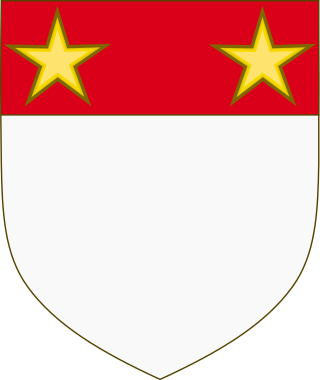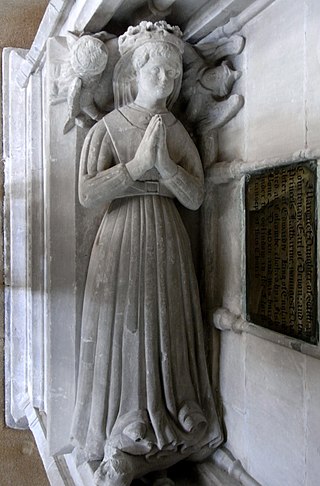
Earl of Devon was created several times in the English peerage, and was possessed first by the de Redvers family, and later by the Courtenay family. It is not to be confused with the title of Earl of Devonshire, held, together with the title Duke of Devonshire, by the Cavendish family of Chatsworth House, Derbyshire, although the letters patent for the creation of the latter peerages used the same Latin words, Comes Devon(iae). It was a re-invention, if not an actual continuation, of the pre-Conquest office of Ealdorman of Devon.

The House of Courtenay is a medieval noble house, with branches in France, England and the Holy Land. One branch of the Courtenays became a royal house of the Capetian dynasty, cousins of the Bourbons and the Valois, and achieved the title of Latin Emperor of Constantinople.

The title Baron Moels was created once in the Peerage of England, in 1299, and passed into abeyance with the death of the fourth lord in 1337. The four men who by modern usage are held to have been Barons Moels were:

Baron St John of Basing is a former title in the Peerage of England. The family of St John of Basing in Hampshire and of Halnaker in Sussex was descended in the male line from the Norman Hugh de Port (d.1091) lord of the manor of Port-en-Bessin in Normandy who took part in the Norman Conquest of England in 1066, and was subsequently granted 53 manors in Hampshire. They had adopted the St. John surname by 1205.)

Margaret Beaufort, Countess of Devon was a great-granddaughter of King Edward III (1327–1377).

Sir Hugh de Courtenay, 2nd/10th Earl of Devon, 2nd Baron Courtenay, feudal baron of Okehampton and feudal baron of Plympton, played an important role in the Hundred Years War in the service of King Edward III. His chief seats were Tiverton Castle and Okehampton Castle in Devon. The ordinal number given to the early Courtenay Earls of Devon depends on whether the earldom is deemed a new creation by the letters patent granted 22 February 1334/5 or whether it is deemed a restitution of the old dignity of the de Redvers family. Authorities differ in their opinions, and thus alternative ordinal numbers exist, given here.

Sir John Courtenay was the third son of Thomas Courtenay, 13th Earl of Devon, and Margaret Beaufort, and was styled Earl of Devon by Lancastrians in exile, following the execution of his brother the 14th earl in 1461.

Margaret de Bohun, Countess of Devon was the granddaughter of King Edward I and Eleanor of Castile, and the wife of Hugh Courtenay, 10th Earl of Devon (1303–1377). Her seventeen children included an Archbishop of Canterbury and six knights, of whom two were founder knights of the Order of the Garter. Unlike most women of her day, she received a classical education and was a lifelong scholar and collector of books.

Hugh de Courtenay, 1st/9th Earl of Devon of Tiverton Castle, Okehampton Castle, Plympton Castle and Colcombe Castle, all in Devon, feudal baron of Okehampton and feudal baron of Plympton, was an English nobleman. In 1335, forty-one years after the death of his second cousin once-removed Isabel de Redvers, suo jure 8th Countess of Devon he was officially declared Earl of Devon, although whether as a new creation or in succession to her is unknown, thus alternative ordinal numbers exist for this Courtenay earldom.

Edward de Courtenay, 3rd/11th Earl of Devon, known by the epithet the "Blind Earl", was the son of Sir Edward de Courtenay and Emeline Dawnay, and in 1377 succeeded his grandfather, Hugh Courtenay, 10th Earl of Devon, as Earl of Devon. The ordinal number given to the early Courtenay Earls of Devon depends on whether the earldom is deemed a new creation by the letters patent granted 22 February 1334/5 or whether it is deemed a restitution of the old dignity of the de Redvers family. Authorities differ in their opinions, and thus alternative ordinal numbers exist, given here.

Sir John Dawney or Dawnay (d.1346/7) was the eldest son of Nicholas Dawney of Mudford Terry, Somerset, and his wife, Elizabeth.

Hugh de Courtenay, 4th/12th Earl of Devon was an English nobleman, son of the 3rd/11th earl of Devon, and father of the 5th/13th earl. The ordinal number given to the early Courtenay earls of Devon depends on whether the earldom is deemed a new creation by the letters patent granted 22 February 1334/5 or whether it is deemed a restitution of the old dignity of the de Redvers family. Authorities differ in their opinions, and thus alternative ordinal numbers exist, given here.
Sir Hugh de Courtenay (1251–1292) was the son and heir of John de Courtenay, feudal baron of Okehampton, Devon, by Isabel de Vere, daughter of Hugh de Vere, 4th Earl of Oxford. His son inherited the earldom of Devon.

Thomas Courtenay, 6th/14th Earl of Devon, was the eldest son of Thomas de Courtenay, 5th/13th Earl of Devon, by his wife Margaret Beaufort, the daughter of John Beaufort, 1st Earl of Somerset, and Margaret Holland, daughter of Thomas Holland, 2nd Earl of Kent. Through his mother, he was a great-great-grandson of King Edward III. The ordinal number given to the early Courtenay Earls of Devon depends on whether the earldom is deemed a new creation by the letters patent granted 22 February 1334/5 or whether it is deemed a restitution of the old dignity of the de Redvers family. Authorities differ in their opinions, and thus alternative ordinal numbers exist, given here.

Sir Edward Courtenay was the eldest son of Edward de Courtenay, 11th Earl of Devon. He fought at Agincourt, and was killed in a sea battle in Henry V's continuing campaigns in Normandy.

Sir Hugh I Courtenay, of Haccombe in Devon, was Sheriff of Devon for 1418/19 and was thrice elected knight of the shire for Devon in 1395, 1397 and 1421. He was a grandson of Hugh de Courtenay, 2nd/10th Earl of Devon (1303–1377), was the younger brother of Edward de Courtenay, 3rd/11th Earl of Devon (1357–1419), "The Blind Earl", and was the grandfather of Edward Courtenay, 1st Earl of Devon (d.1509), KG, created Earl of Devon in 1485 by King Henry VII. He was the link between the senior line of the Courtenay Earls of Devon made extinct following the Battle of Tewkesbury in 1471 and the post-Wars of the Roses creation of a new Earldom for his grandson made in 1485 by King Henry VII.

Hugh Courtenay was an English soldier and heir apparent to the earldom of Devon.

Sir Hugh Courtenay, KG, was the eldest son and heir apparent of Hugh Courtenay, 10th Earl of Devon (1303–1377), whom he predeceased, and was a founding member of the Order of the Garter.

The feudal barony of Okehampton was a very large feudal barony, the largest mediaeval fiefdom in the county of Devon, England, whose caput was Okehampton Castle and manor. It was one of eight feudal baronies in Devonshire which existed during the mediaeval era.

The feudal barony of Plympton was a large feudal barony in the county of Devon, England, whose caput was Plympton Castle and manor, Plympton. It was one of eight feudal baronies in Devonshire which existed during the medieval era. It included the so-called Honour of Christchurch in Hampshire, which was not however technically a barony. The de Redvers family, first holders of the barony, were also Lords of the Isle of Wight, which lordship was not inherited by the Courtenays, as was the barony of Plympton, as it had been sold to the king by the last in the line Isabel de Redvers, 8th Countess of Devon (1237–1293).
















